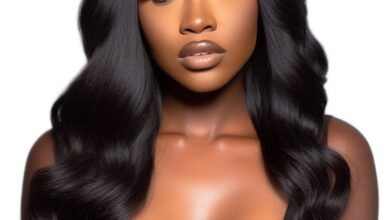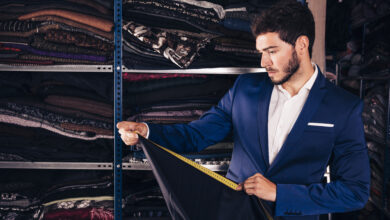Top Things to Consider When Shopping for a 360 Lace Frontal Wig
A 360 lace frontal wig offers a unique edge compared to other wig types. Unlike traditional frontal wigs that cover only the hairline from ear to ear, a 360 lace frontal wig extends the lace all around the perimeter of your head.
It’s crucial to know what makes 360 lace frontal wigs unique from other wig varieties when you’re buying one. Unlike traditional lace front wigs that only cover the hairline, a 360 lace frontal wig has lace around the entire perimeter, allowing for more versatile styling, such as high ponytails or updos.
The anatomy of a 360 lace frontal includes a combination of lace and a machine-made wig cap. The lace covers the hairline and extends around the head, while the center is typically constructed with thicker material for durability. Wig density (the amount of hair on the wig) also plays a major role in determining how full or natural the wig will look.
Choosing Between Standard Lace and HD Frontal
When deciding between a standard lace frontal and an HD lace frontal, understanding the key differences in transparency, blendability, and durability is essential for selecting the best option for your style.
Differences in Lace Types:
- Transparency: One of the biggest differences between standard lace and HD lace is transparency. Standard lace is thicker and slightly more visible, making it easier to detect, especially on lighter skin tones. While it can still look natural with the right application, standard lace may require more effort to blend seamlessly with your scalp.
- Blendability: Standard lace wigs can still be blended with makeup or lace tinting to match your skin tone, but it requires a bit more skill to create a perfect transition. HD lace, on the other hand, requires little to no customization to blend with the skin. The thin material is designed to melt into the scalp, creating a seamless hairline that mimics natural hair growth. This makes HD lace the preferred choice for those aiming for a flawless, undetectable look.
- Durability: When it comes to durability, regular lace is more resilient than delicate HD lace, withstanding greater wear and tear. Standard lace is ideal for those who wear wigs regularly and need a wig that can handle frequent use. HD lace, while more delicate, requires extra care and gentler handling to avoid tears or damage.
Deciding on the Right Hair Type and Texture
When choosing a 360 lace frontal wig, selecting the right hair type and texture is crucial for both the look and longevity of your wig. Your choice between virgin hair and processed hair, along with the texture, will determine how well your wig holds up to styling, as well as how natural it appears.

Choosing Virgin Hair vs. Processed Hair for Frontal Wigs
- Virgin Hair: Virgin hair is unprocessed and completely natural, meaning it has never been treated with chemicals, dyes, or heat. The cuticles of virgin hair remain intact and aligned, which gives the hair a more natural shine and softness.
- Processed Hair: Processed hair has been treated with chemicals, dyes, or heat to achieve a specific color or texture. While not as natural as virgin hair, processed hair can still be a good option, depending on your styling preferences.
Selecting the Perfect Wig Length and Cut
When deciding on the right length and cut for your 360 lace frontal wig, consider your style, face shape, and the look you want to achieve.
- Frontal Bob Wigs: A bob cut is a timeless, versatile choice that works well for many face shapes and styles. The shorter length maintains a stylish, contemporary appearance while being simple to handle and style. A frontal bob wig is ideal for those who want a low-maintenance but fashionable look, and it’s perfect for showcasing the natural-looking hairline created by the lace frontal.
- Mid-Length Wigs: If you prefer a bit more length, mid-length wigs (shoulder-length or just below the shoulders) offer a nice balance between easy styling and added versatility. This length works well for both straight and wavy textures, offering enough length for updos and other styles without the weight and maintenance of longer hair.
- Long Wigs: For a more dramatic and glamorous look, long wigs are the way to go. Whether sleek and straight or with flowing waves, longer lengths offer more styling options, from high ponytails to intricate updos.
Cap Size and Adjustability for Optimal Fit
Choosing the appropriate cap size and guaranteeing adjustability is crucial to attaining a snug and cozy fit for your 360 lace frontal wig.
- Adjustable Straps and Elastic Bands: You can change the fit of most 360 lace frontal wigs by using the adjustable straps and rubber bands that come with them. These features are essential for ensuring that the wig stays securely in place without slipping throughout the day.
- Cap Size: Choosing the right cap size is crucial for both comfort and appearance. If the cap is too small, it can cause discomfort and may not fit securely, while a cap that’s too large may slip or cause the wig to appear bulky. Always measure your head and choose a wig with a cap size that corresponds to your measurements for the best fit.
Conclusion

Choosing the right 360 lace frontal wig requires careful consideration of the lace type, hair texture, wig length, and cap fit. By understanding the unique features of a 360 lace frontal and how to tailor it to your preferences, you can achieve a flawless, natural look that perfectly suits your style. Whether you opt for HD lace for an invisible finish or a versatile bob cut, making informed decisions will help you find the perfect wig to enhance your beauty.


